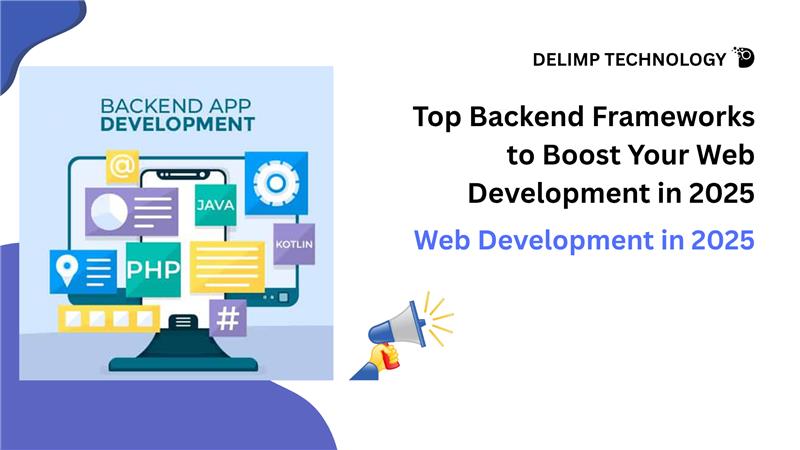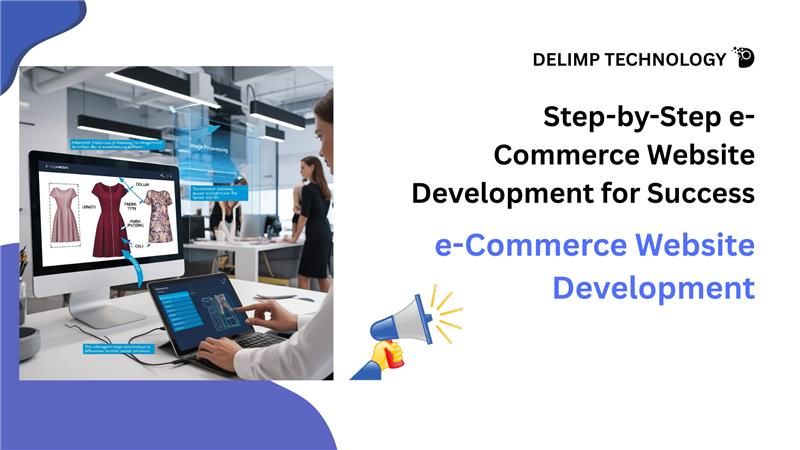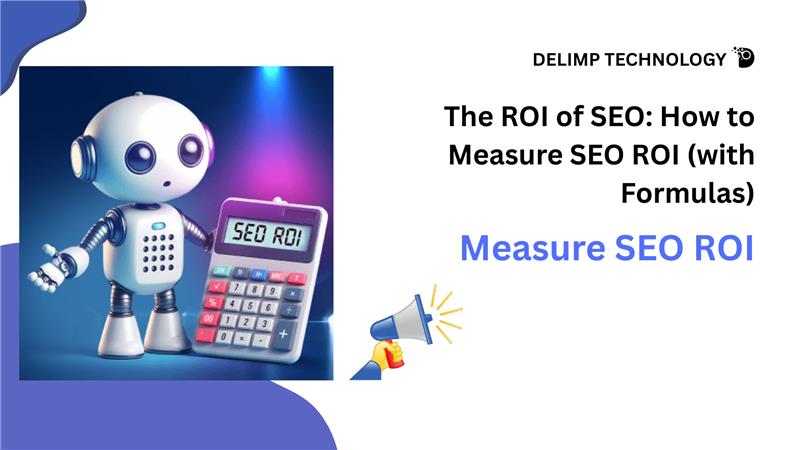In the ever-evolving world of web development, choosing the right backend framework can make or break your project’s success. As we step into 2025, web applications are becoming more complex, scalable, and performance-driven. Backend frameworks now play a crucial role in ensuring efficiency, speed, and security while simplifying the Web Development Process. Whether you’re building a startup product, an enterprise platform, or an eCommerce site, selecting the right framework is key.
Here’s a detailed look at the Top Backend Frameworks that are set to dominate web development in 2025.
Why Choose Delimp Technology?
Choose Delimp Technology for web development services that deliver innovation, performance, and results. Our expert team builds responsive, user-friendly, and SEO-optimized websites designed to boost your online presence and drive growth. We focus on advanced technology, seamless functionality, and creative design. We help businesses stand out. We engage customers and achieve lasting digital success.
1. Node.js – The JavaScript Powerhouse
Primary Language: JavaScript
Best For: Real-time applications, APIs, and microservices
Node.js continues to lead the backend development ecosystem in 2025. Its non-blocking, event-driven architecture allows developers to build highly scalable and fast applications. With Nodejs Development Services, you can use JavaScript for both frontend and backend, creating a seamless full-stack development experience.
Why It Stands Out:
- Exceptional speed powered by Google’s V8 engine
- Massive NPM (Node Package Manager) ecosystem
- Ideal for real-time apps like chats and gaming platforms
- Highly compatible with microservice architecture
Popular Use Cases: Netflix, LinkedIn, and Uber all leverage Node.js for performance and scalability.
2. Django – The Python Framework of Choice
Primary Language: Python
Best For: Rapid development, startups, and secure web apps
Django remains one of the most reliable backend frameworks in 2025 due to its “batteries-included” philosophy. It comes packed with pre-built components for user authentication, admin panels, and database management, enabling rapid development.
Why It Stands Out:
- High-level abstraction for clean and efficient code
- Strong security features (CSRF and XSS protection)
- Built-in ORM (Object Relational Mapping) for easy database handling
- Excellent for scalable applications
Popular Use Cases: Instagram, Spotify, and Pinterest rely on Django for handling millions of users seamlessly.
3. Laravel – The PHP Framework with Elegance
Primary Language: PHP
Best For: Web apps, SaaS platforms, and eCommerce solutions
Laravel continues to reinvent PHP development in 2025 with its elegant syntax, powerful tools, and extensive ecosystem. Known for its ease of use, Top Laravel Development Services makes building complex applications enjoyable. It offers features like routing, caching, and session management.
Why It Stands Out:
- Built-in support for MVC (Model-View-Controller) architecture
- Artisan CLI for automation
- Blade templating engine for intuitive front-end integration
- Integrated testing support
Popular Use Cases: Laravel powers platforms like Alison, MyRank, and OctoberCMS.
4. Spring Boot – Enterprise-Level Java Framework
Primary Language: Java
Best For: Enterprise applications, microservices, and APIs
Spring Boot continues to dominate the enterprise development scene in 2025. It simplifies the Java development process by removing the need for complex configurations. The framework is highly modular and ideal for building production-ready applications with minimal effort.
Why It Stands Out:
- Simplified dependency management
- Seamless integration with cloud-based services
- Robust security with Spring Security
- Large developer community and extensive documentation
Popular Use Cases: Used by companies like Amazon, Netflix, and Google for large-scale enterprise applications.
5. Ruby on Rails – Productivity with Convention
Primary Language: Ruby
Best For: MVPs, startups, and quick product launches
Ruby on Rails (RoR) continues to be a solid choice for startups and rapid prototyping in 2025. It follows the “Convention over Configuration” principle, allowing developers to focus more on building features rather than managing configurations.
Why It Stands Out:
- Speed and productivity for small teams
- Integrated testing framework
- Active community and mature ecosystem
- Excellent for building RESTful APIs
Popular Use Cases: GitHub, Shopify, and Airbnb started with Ruby on Rails.
6. Express.js – Minimal and Flexible
Primary Language: JavaScript
Best For: Lightweight APIs and single-page applications
Express.js, often used with Node.js, remains one of the most popular backend frameworks for developers who value flexibility. It’s minimalistic yet powerful, making it ideal for building Custom RESTful APIs quickly and efficiently.
Why It Stands Out:
- Lightweight and unopinionated
- Supports middleware for extensibility
- Perfect companion for MERN (MongoDB, Express, React, Node) stack
- Fast setup for small to medium-sized projects
Popular Use Cases: PayPal and IBM use Express.js for scalable web solutions.
7. Flask – Lightweight and Flexible Python Framework
Primary Language: Python
Best For: Small-scale applications, APIs, and microservices
Flask is the go-to choice for developers who want simplicity and flexibility. Unlike Django, Flask doesn’t impose structure, giving developers complete control over how to organize their applications.
Why It Stands Out:
- Minimalistic and easy to learn
- Excellent for prototyping and APIs
- Works well with modern technologies like TensorFlow or PyTorch
- Ideal for microservices architecture
Popular Use Cases: Netflix, Reddit, and Lyft use Flask for specific backend services.
8. FastAPI – The Rising Star
Primary Language: Python
Best For: High-performance APIs and AI-driven applications
FastAPI has rapidly gained traction as one of the fastest and most efficient backend frameworks. It’s built on modern Python features like type hints and asynchronous programming, delivering incredible performance and scalability.
Why It Stands Out:
- Lightning-fast performance (built on ASGI and Starlette)
- Automatic API documentation via Swagger
- Type safety and validation
- Perfect for machine learning and IoT apps
Popular Use Cases: Microsoft and Uber use FastAPI for data-driven services.
Comparison Table: Top Backend Frameworks of 2025
| Framework | Language | Ideal For | Key Strength |
| Node.js | JavaScript | Real-time apps | Scalability |
| Django | Python | Secure web apps | Rapid Development |
| Laravel | PHP | SaaS, eCommerce | Elegant syntax |
| Spring Boot | Java | Enterprise apps | Cloud Integration |
| Ruby on Rails | Ruby | Startups | Convention-based coding |
| Express.js | JavaScript | APIs | Flexibility |
| Flask | Python | Microservices | Simplicity |
| FastAPI | Python | AI apps | High-performance |
Final Thoughts
The backend framework you choose in 2025 will depend on your project’s goals, team expertise, and scalability needs. Node.js and Express.js dominate for JavaScript ecosystems. Django and FastAPI shine in Python-driven applications. Spring Boot remains unmatched for enterprise-grade Java solutions. Whichever framework you pick, focus on aligning it with your project’s long-term vision. The right choice won’t just streamline development, it will future-proof your web application for years to come.





